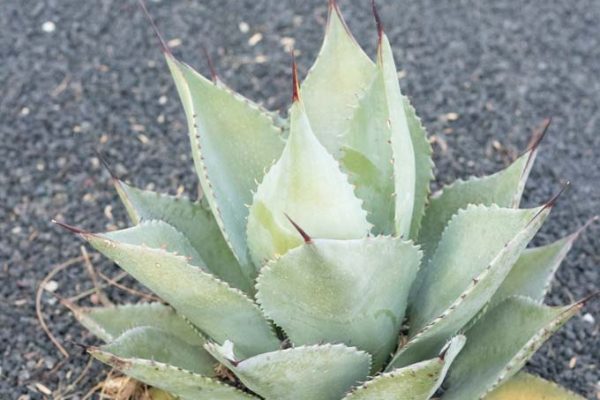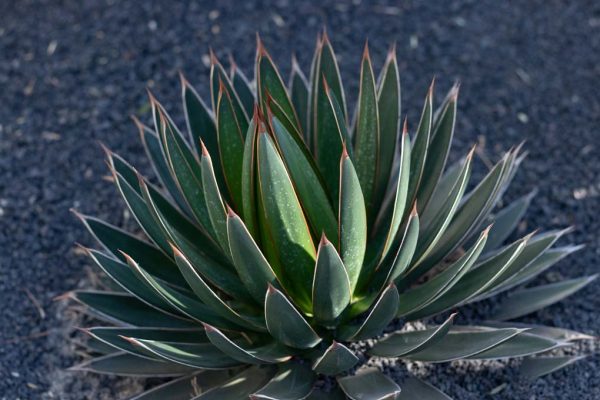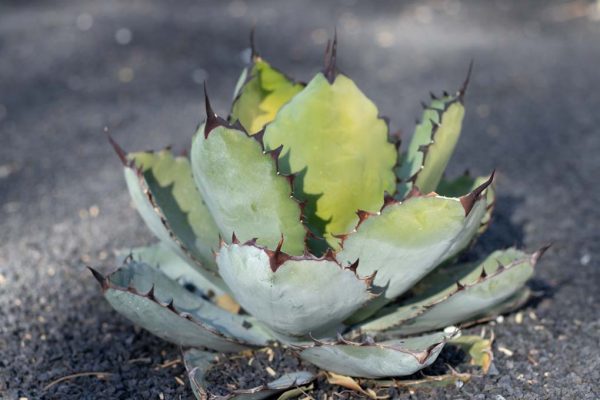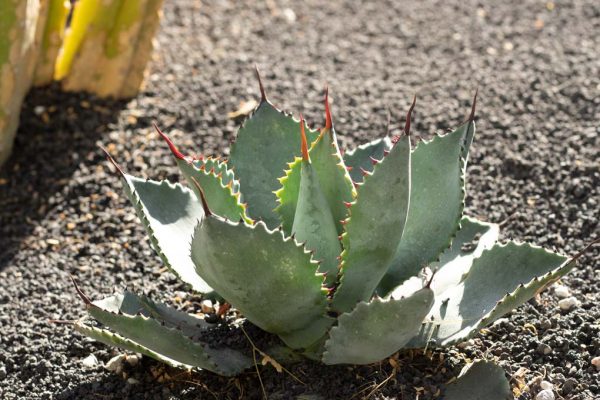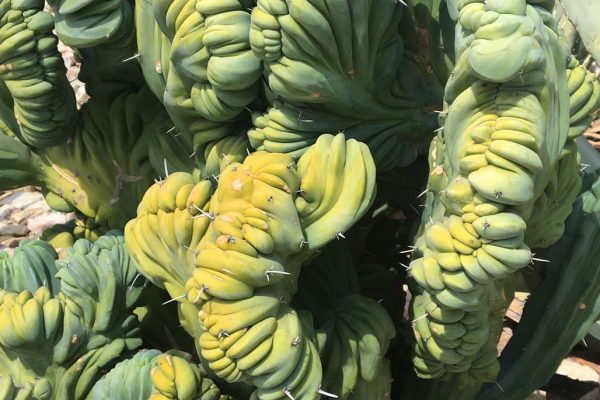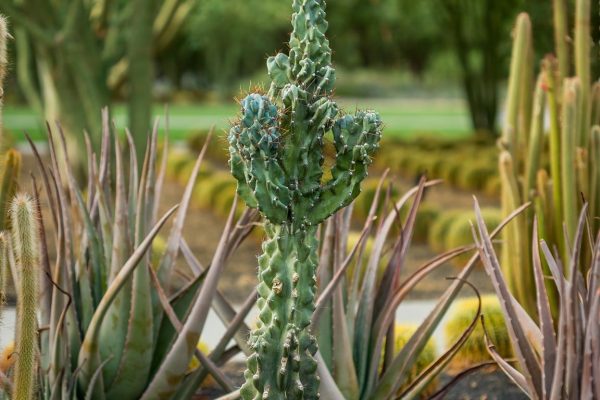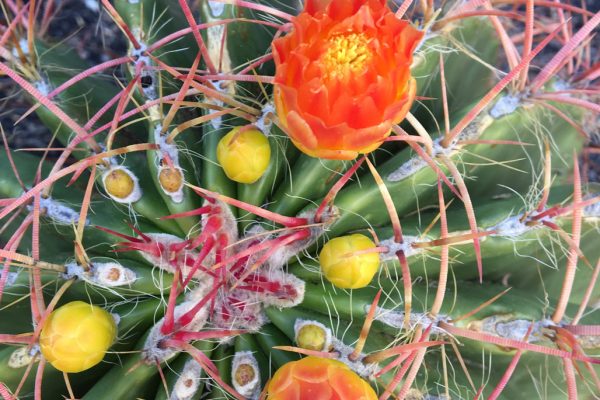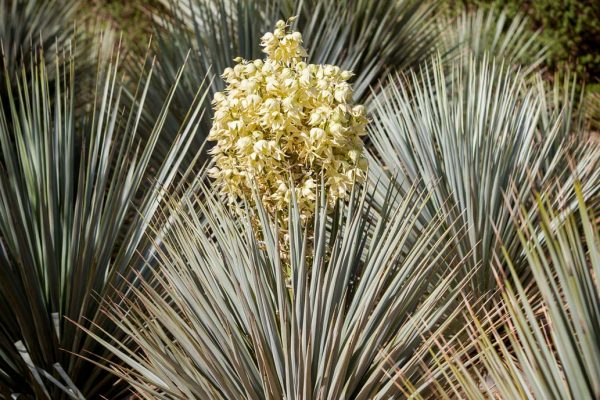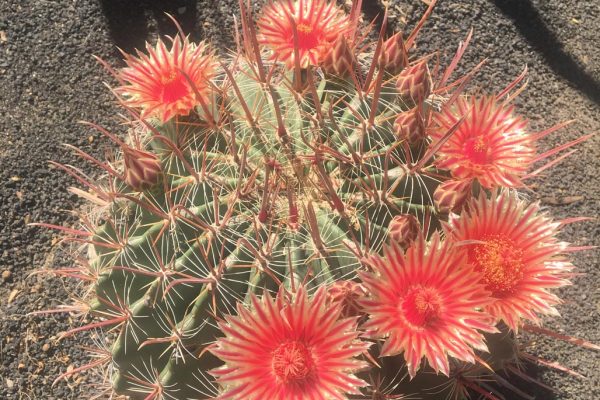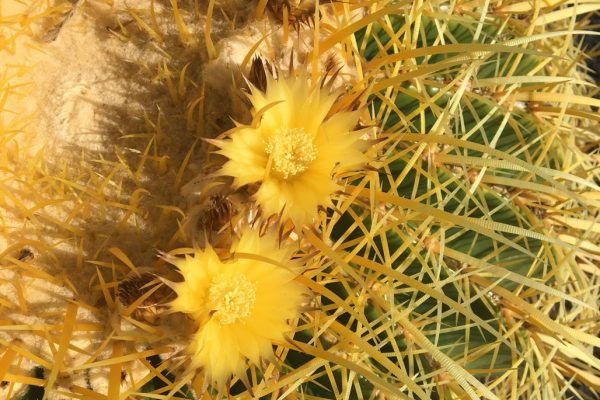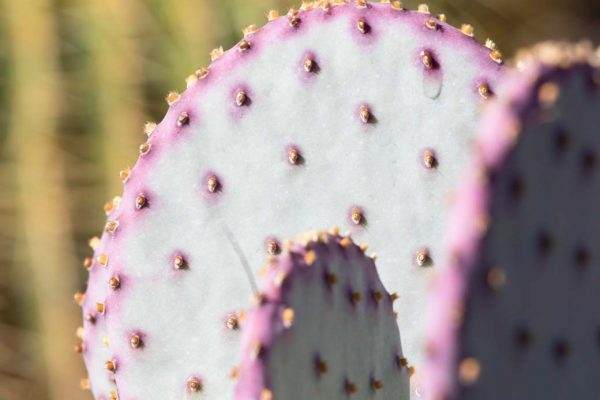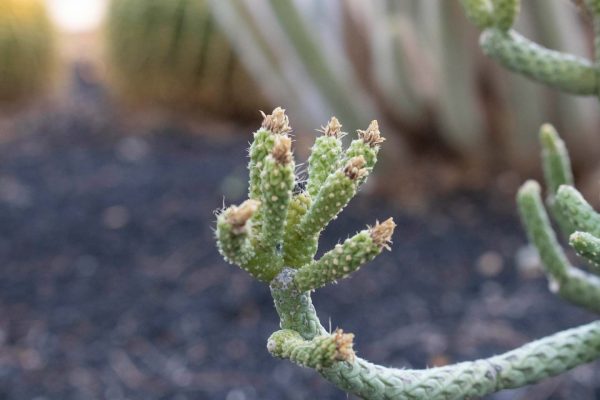This 2021 garden addition is planted in specimen beds nearest the solar fields. A medium agave, it grows up to 3 feet wide with pale green to gray leaves that curve cup-like towards the center. Curved teeth also line the black leaf margin and end in a long, black terminal spine.
These plants originate in the more temperate climates of the islands west of Baja, California, on West San Benito, Natividad and their namesake, Cedros Islands. They are also being cultivated from tissue cultures.
This hardy agave, which can stand temperatures down to 15°F, is in the specimen beds nearest the solar field. It can tolerate shade but prefers sun. With rosettes of straight narrow toothless leaves, growing 2 to 3 feet tall, it resembles a yucca. Like the yucca, it has been harvested for its leaf fibers, which gives it its name meaning fiber or cord.
It will grow an 8-foot tall stalk at its end of life with yellow blooms. Unlike other agaves, it does not form clones or offsets.
Native to Sonora, Mexico, this agave seems to prefer rocky slopes at an elevation between 1,500 and 4,500 feet.
This new variety has replaced the original Gentry’s Agave (Agave titanota) in the south-west corner of section 1 on the map. Smaller than the original Gentry’s Agave, this one can have blue-gray to green leaves and black teeth along its leaf margins.
It can grow to a height of 2 feet and spread up to 3 feet, and will produce clones, creating tightly packed colonies.
This titanota variety originated in Oaxaca, Mexico, and was grown by seed, but is now also being propagated in labs through tissue culturing. It’s not certain whether this plant qualifies as a cultivar or hybrid as several varieties of A. titanota are now being described as a new species of their own.
Added to the gardens in 2021, Pygmaea Agave is a new dwarf variety. It is dark green with flat leaves rarely exceeding 12 inches (30 cm) in length. It can be found in the far north specimen beds near the solar field.
Pygmaea prefers a limestone habitat. Its origins are in Mexico, Chiapas, and north of the Mexico-Guatemala border.
A slow grower, it does well in heat but is frost tender.
You may find it under the botanical name of Agave Pygmaea Gentry or Agave seemanniana subsp. Pygmaea, which is how it is listed on this site.

Crested Blue Flame is in the north specimen bed nearest the Café and Solar Field. It’s easily identified by its shape, which is a series of heavily folded skin. It makes it eye-catching. This feature has resulted in a variety of common names including Dinosaur Back, as well as “Crested” followed by multiple descriptive names. All an attempt to capture this unique growth pattern.
The pattern could best described as clustering, since it grows a trunk-like center crest, and then sends up additional stems that will grow around each other, thus forming a cluster. It makes an interesting addition to any garden space as quite an attractive curiosity.
At Sunnylands, it elicits questions from visitors, including “What’s wrong with that cactus?” For those used to more recognizable patterns of barrel, columnar, and pad producing cactus, this one is a surprise.
It’s also a growth pattern we see in other ecosystems, like the coral reefs. The corals are colonies of organisms that act as one, but the cactus creates this visual effect as a single organism.
The blooms are small with radiating petals and greenish-white in color.
The Night Blooming Cereus has some variability in its growth. It mainly grows similar to a tree-form, having stems that curve upward resembling branches. At maturity it can reach as high as 35 feet. Spines may be completely absent or grow as long as two inches.
This cactus has bloomed at Sunnylands producing a large, beautiful white bloom, tipped in pinks and reds. The bloom is followed by a red fruit with white pulp.
Assumed to be native to Venezuela and the Caribbean, but due to wide cultivation and distribution, this is not confirmed.
Also: Cereus repandus (Anderson)
This vibrantly colored cactus can grow solitary or in groups with spines that range from yellow to bright red and may even be combined on one plant. The spines have distinct banding and a slight curve. In the gardens they can be found in the specimen beds at the shuttle gate and nearest the solar field.
Flowers are a bright yellow and red-orange blend, which are followed by yellow fruit at the crown.
Their distribution is throughout Northern Central Mexico in San Luis Potosí, Zacatecas, Durango, Nuevo León, Coahuila, and Tamaulipas.

Beaked Yucca is most obvious in the wildflower field. Entering from the path that starts in the middle of the parking lot and taking the route to the left, it lies immediately ahead on the left side of the path. When it was originally planted at ground level, it appeared like rigid bunch grass. In recent seasons, it began to be more obvious as a trunking species that will rise up between 6 and 15 feet. As each new row of leaves dies, it falls downward to create a skirt effect on the trunk. It can grow single or multi-headed branches. Its leaves are mostly rigid and may or may not have a slight curve.
Rostrata, like other yuccas, is truly in its glory when it blooms. Its large candelabras of pure white blooms signals that it is another species attractive to nocturnal pollinators, which is common in the desert. The main pollinator of yuccas is the Yucca Moth. They have a special symbiotic relationship with this genus and, although other pollinators may visit, the Yucca Moth is the real partner. The plant’s fruit is shaped with a point like a beak, which is why it is nicknamed Beaked Yucca.
The distribution of Beaked Yucca is in the states of Chihuahua and Coahuila in northern Mexico, and western Texas in the United States.
Fish Hook is found in specimen beds between the café and solar field, and around the wildflower field. This barrel, from the same genus as the Blue Barrel, is easy to distinguish by the variety of its spines’ shapes. The name comes from large, flat spines that appear on this cactus and curve to form a hook. These central spines have been used by the local Seri people as fish hooks, and all parts of the cactus have been used for food or tools.
Flowers range from yellow to orange, followed by yellow ovoid fruit.
Distribution includes central and southern Arizona, New Mexico, southwestern Texas; and Chihuahua, Sonora, and Sinaloa in northern Mexico.

The Golden Barrel cactus forms dense wooly caps, from which it can grow crowns of yellow, cup-shaped blooms in spring and summer. These cactuses, like agaves and many other succulents, also produce clones and can create a colony of barrels all stemming from one parental plant.
At Sunnylands, this showstopper is planted in the scoria-mulched beds under the Palo Breas, adjacent the Center. Planted alone in rows, it draws visitors with cameras trying to capture unique views that emerge below the Palo Brea trees. In other parts of the gardens, it shares the spotlight with the San Pedro cactus.
Mary Irish, horticultural consultant on the project, describes these spotlights: “San Pedro cactus and Golden Barrel cactus are set like twin jewels on the dark base. This dramatic presentation is one of the artistic gems visitors find while wandering through the gardens.”
At sunset, the bright green flesh and yellow spines create a glowing effect that looks as if they radiate light.
This cactus, included on the Convention for International Trade of Endangered Species (CITES) list, is endangered in the wild. Transport across international lines is restricted as the demand for certain desirable species often results in their depletion at their home of origin, as they are poached and transported to private collections around the world. Now heavily commercially cultivated, they are more available, but as the plants grow to larger sizes, their price point increases, leaving older, wild specimens in danger of being poached.
Santa Rita is found in the specimen beds between the café and the solar field among a variety of other Opuntias. This species grows in mounds and doesn’t form a central stem that some other of the genus will. Santa Rita’s pad is very round, rather than obovate (egg-shaped), and is a blend of gray-green and violet-purple.
The cup-shaped flowers have a red base that turn yellow moving up the petal. Its bloom is followed by spineless, purplish-red fruit.
Distribution of Santa Rita is southeastern Arizona, southern New Mexico, western Texas, and northern Sonora, Mexico.
The Walking Stick or Cane Cholla is a compact tree-like cholla that produces unique looking whorled branches. In water, it follows the pattern of some other cholla species and turns a flush of purple. It has the ability to form hybrids with other chollas, including Teddy Bear or Jumping Cholla, which is also planted in the specimen bed.
It blooms red to purple, yellow, or white blossoms, followed by spineless fruit that are yellow tinged with purple and will remain on the cactus until the following spring.
Its origins are the desert and grasslands of Arizona and New Mexico in the United States and the states of Sonora and Chihuahua in Mexico. It prefers high elevations well over 6,000 feet, due to a strong frost tolerance.
